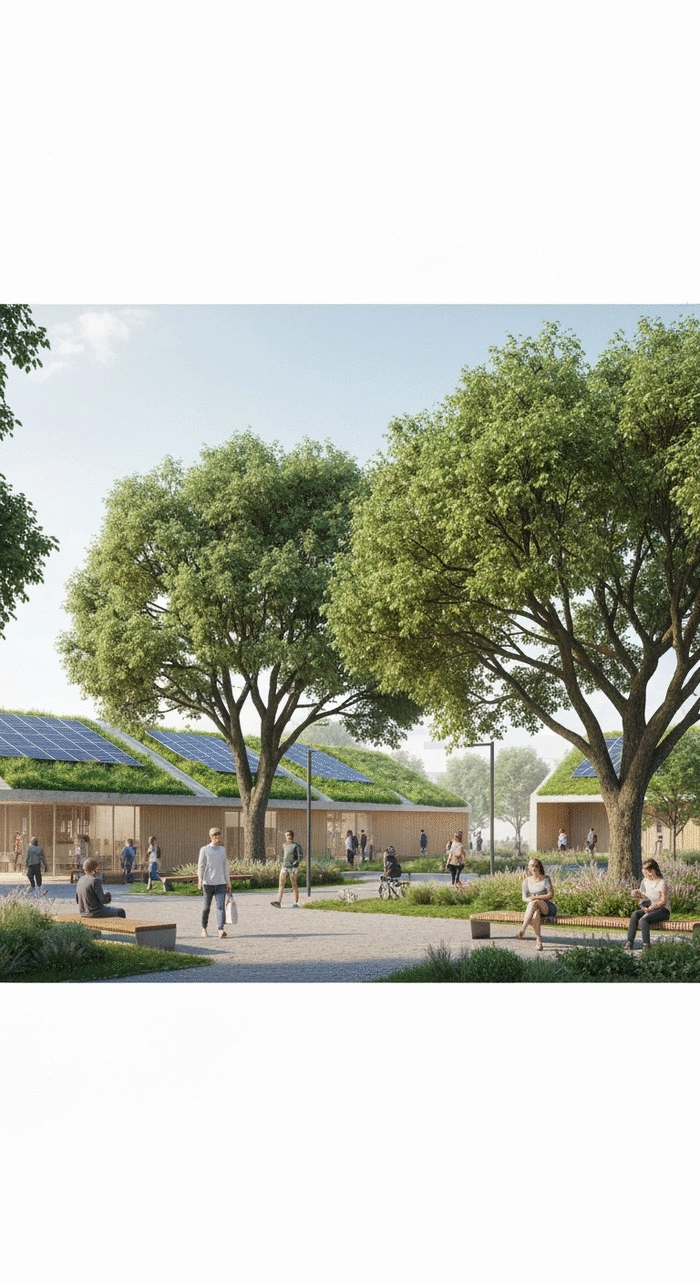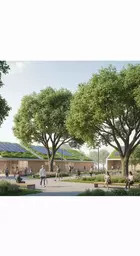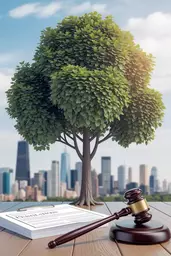Trees in Sustainable Urban Growth

Posted on: 2025-11-14
By: Keira Vallejo
Have you ever stopped to think about how the trees lining your city streets do more than just beautify the landscape? These living giants are the backbone of sustainable urban development, playing an integral role in our city’s health and resilience. As we delve into the significance of green infrastructure, particularly trees, we'll uncover how they contribute to creating thriving urban environments.
What You Will Learn
- Benefits of Urban Trees: Trees improve air quality, reduce heat, and manage stormwater, making cities more livable.
- Core Components of Green Infrastructure: Understanding vegetation, permeable surfaces, green roofs, and wetlands is essential for sustainable urban planning.
- Economic and Social Value: Urban trees increase property values, lower energy costs, and enhance community cohesion.
- Encouraging Community Involvement: Engaging residents in tree planning and maintenance fosters a sense of belonging and supports equitable green space distribution.
- Technological Innovations: Tools like mobile apps and smart sensors are revolutionizing urban forest management, promoting sustainability.
- Financing Urban Greening: Exploring grants, public-private partnerships, and incentive programs is crucial for supporting tree initiatives in cities.
Key Benefits of Trees in Urban Sustainability
Exploring the multifaceted advantages of integrating trees into urban environments leads to improved quality of life and sustainability.
Environmental Impact
Improves air quality, reduces urban heat, and aids in stormwater management.
Economic Value
Increases property values and lowers energy costs.
Social Benefits
Provides recreational spaces and enhances community cohesion.
Climate Resilience
Acts as carbon sinks, helping cities combat climate change.
Understanding the Role of Green Infrastructure Trees in Urban Sustainability
Have you ever considered how trees play a vital role in making our cities more livable? At Urban Canopy Blog, we believe that trees are a crucial part of *sustainable urban environments*. They're more than just pretty plants; they are essential components of *green infrastructure*. Green infrastructure refers to the network of natural and semi-natural systems that provide essential services. By incorporating trees into our cities, we can create healthier and more sustainable urban landscapes.
When we talk about sustainable city growth, we need to think about the many ways trees contribute. They help lower temperatures, improve air quality, and manage stormwater. In the long run, these benefits lead to more resilient cities that can better handle the challenges posed by climate change. By understanding the *intersection of trees and sustainable growth*, we can advocate for more green spaces in our neighborhoods!
The Intersection of Trees and Sustainable City Growth
As we dive deeper into the intersection of trees and sustainable growth, let’s highlight a few crucial benefits:
- Improved Air Quality: Trees filter pollutants and produce oxygen, making our air healthier to breathe.
- Energy Savings: By providing shade, trees help reduce energy costs for cooling in the summer.
- Enhanced Biodiversity: Urban trees create habitats for various species, promoting a diverse ecosystem.
- Stormwater Management: Trees absorb rainwater, reducing runoff and minimizing flooding risks.
Each of these benefits contributes to making our urban spaces more sustainable and enjoyable. Trees, through their roles in green infrastructure, provide a framework for cities to grow responsibly. So, when we think about urban planning, let's not forget the importance of including these green giants in our designs! Now is also a great time to consider the benefits of professional tree care in maintaining these vital assets.
Defining Green Infrastructure and Its Core Components
To fully grasp the significance of trees in urban sustainability, we must define what *green infrastructure* truly entails. This concept encompasses various natural systems that work together to create a more sustainable environment. Trees are at the heart of this framework, offering numerous benefits and services.
Some core components of green infrastructure include:
- Vegetation: Trees, shrubs, and plants that absorb carbon and provide shade.
- Permeable Surfaces: Materials that allow water to pass through, reducing runoff.
- Green Roofs: Rooftop gardens that help insulate buildings while providing green space.
- Wetlands: Natural areas that filter water and provide habitat for wildlife.
By integrating these elements into urban planning, cities can enhance their resilience to climate change and improve the quality of life for their residents. At Urban Canopy Blog, we’re excited to share more about how trees fit into this framework and their powerful role in sustaining our urban environments!
Pro Tip
To maximize the benefits of urban trees, consider implementing a community tree stewardship program. Engaging local residents in the care and maintenance of trees not only fosters a sense of ownership but also enhances community ties and ensures the longevity of green infrastructure investments. Collaborative efforts can lead to healthier trees and more vibrant urban spaces!
Conclusion: The Future of Urban Growth Through Green Infrastructure
As we wrap up our exploration of the vital role trees play in urban sustainability, it’s clear that their benefits are both multifaceted and profound. Trees are not just beautiful additions to our city landscapes; they are essential components of sustainable urban growth. By integrating trees into our planning and infrastructure, we pave the way for healthier, more resilient cities that can thrive both now and in the future.
From enhancing air quality to managing stormwater, the advantages of urban trees are numerous. They contribute to the overall well-being of communities while also helping combat climate change. Emphasizing green infrastructure with a focus on trees can lead to a brighter future for our urban spaces. So, let’s take action and embrace the potential of trees in our cities!
Synthesizing the Benefits of Integrating Trees in Urban Planning
When we consider all that trees offer, it’s hard to ignore their ability to transform urban environments. Here’s a quick summary of their key benefits:
- Environmental Impact: Trees improve air quality, reduce urban heat, and help manage stormwater.
- Economic Value: Urban trees increase property values and lower energy costs.
- Social Benefits: They provide recreational spaces and enhance community cohesion.
- Climate Resilience: Trees act as carbon sinks, helping cities combat climate change.
At Urban Canopy Blog, I’ve seen firsthand how fostering a deeper understanding of these benefits can empower communities to take action. By engaging with residents and local stakeholders, we can ensure that every tree planted is a step towards a healthier urban ecosystem. For example, urban trees can significantly cool city heat, creating more comfortable environments for residents.
Encouraging Municipal Policy Adoption and Community Involvement
It's time for municipal planners to consider comprehensive tree planning strategies that support equitable distribution across urban landscapes. This means developing policies that prioritize green infrastructure and encourage community involvement. Here are a few key steps:
- Incorporate tree planting initiatives into urban development plans.
- Engage residents in discussions about their preferences for green spaces.
- Provide educational resources about the benefits of urban trees.
- Establish partnerships with local organizations for tree care and maintenance.
By working together, we can create cities that not only thrive but also foster a sense of belonging and well-being. As we look to the future, let’s continue to advocate for trees in urban planning—because every tree makes a difference!
Frequently Asked Questions (FAQs)
What are the main benefits of urban trees?
Urban trees offer numerous benefits, including improved air quality, reduced urban heat, increased property values, enhanced community cohesion, and climate resilience.
What does green infrastructure encompass?
Green infrastructure includes vegetation (trees, shrubs, plants), permeable surfaces, green roofs, and wetlands. These elements work together to create sustainable urban environments.
How can communities get involved in urban tree initiatives?
Communities can get involved by participating in tree planting initiatives, engaging in discussions about green space preferences, and supporting local organizations involved in tree care and maintenance.
What role do technological innovations play in urban forest management?
Technological innovations such as mobile apps (e.g., TreeTrack), smart sensors, and GIS software enhance the efficiency and effectiveness of urban forest management by enabling data-driven decision-making.
What are some financing options for urban greening projects?
Financing options include grants from federal and state governments, public-private partnerships with businesses, and incentive programs that provide tax benefits to homeowners who plant or maintain trees.
Further Resources and Opportunities for Engagement
Accessing Tools for ROI Calculations and Financial Modeling
Municipalities looking to assess the financial impact of urban tree initiatives can benefit from various tools and templates. Here are some resources to consider:
- i-Tree: A free suite of tools for urban forestry analysis.
- Tree Benefit Calculator: Estimates the economic value of trees in urban areas.
- Green Infrastructure Valuation Toolkit: Provides methods to evaluate the benefits of green infrastructure.
Utilizing these tools can help cities quantify the return on investment for their tree planting projects, making a compelling case for the importance of urban forestry. At Urban Canopy Blog, I encourage everyone to explore these resources and get involved! When planning these initiatives, be sure to incorporate optimal tree planting times for the best results.
Exploring Technological Innovations in Urban Forest Management
With advancements in technology, managing urban trees has become more efficient and effective. Here are some innovative platforms and systems to consider:
- TreeTrack: A mobile app for tracking tree health and maintenance.
- Smart Sensors: Devices that monitor soil moisture and tree vitality.
- GIS Software: Geographic Information Systems that aid in planning and mapping canopy cover.
By leveraging these technologies, urban foresters can make informed decisions that promote sustainable practices and ensure the health of urban forests. As a passionate advocate for green infrastructure, I believe we can harness these tools to enhance our urban landscapes.
Green Infrastructure Financing and Policy Frameworks for Sustainability
Finally, understanding financing options and policy frameworks is crucial for supporting urban forestry initiatives. Here are some avenues to explore:
- Grants and Funding: Look for federal and state grants dedicated to urban greening efforts.
- Public-Private Partnerships: Collaborate with businesses to fund tree planting projects.
- Incentive Programs: Create tax incentives for homeowners who plant or maintain trees.
By advocating for supportive policies and financial resources, we can ensure that urban trees remain a priority in city planning. Together, let’s strive for greener, healthier cities for generations to come! Ensuring that the soil quality is adequate for planting urban trees.
Recap of Key Points
Here is a quick recap of the important points discussed in the article:
- Role of Trees: Trees are vital for creating sustainable urban environments by providing essential services as part of green infrastructure.
- Benefits of Urban Trees: They improve air quality, enhance biodiversity, provide energy savings, and manage stormwater effectively.
- Green Infrastructure Components: Key elements include vegetation, permeable surfaces, green roofs, and wetlands that work together to create a more sustainable urban space.
- Community Engagement: Municipal planners should prioritize tree planting initiatives and engage communities in discussions about their green space preferences.
- Technological Innovations: Utilizing apps, smart sensors, and GIS software can enhance urban forest management and promote sustainability.
- Financing and Policy Support: Explore grants, public-private partnerships, and incentive programs to support urban greening efforts.
 Have you ever stopped to think about how the trees lining your city streets do more than just beauti
Have you ever stopped to think about how the trees lining your city streets do more than just beauti
 In urban environments, trees are often the unsung heroes contributing to our well-being and the over
In urban environments, trees are often the unsung heroes contributing to our well-being and the over
 Urban trees are essential to our cities, yet they face numerous threats from pests and diseases. Did
Urban trees are essential to our cities, yet they face numerous threats from pests and diseases. Did